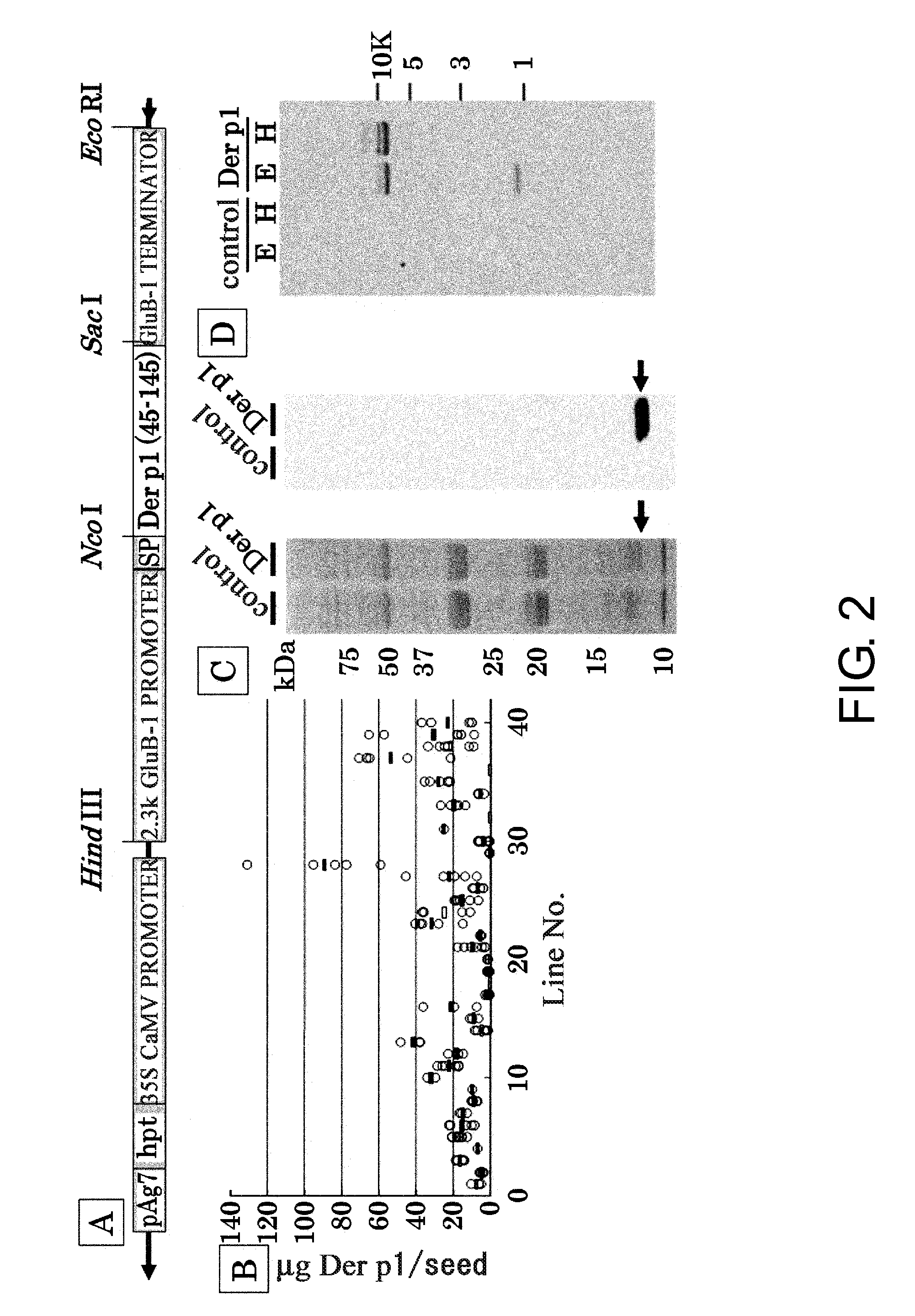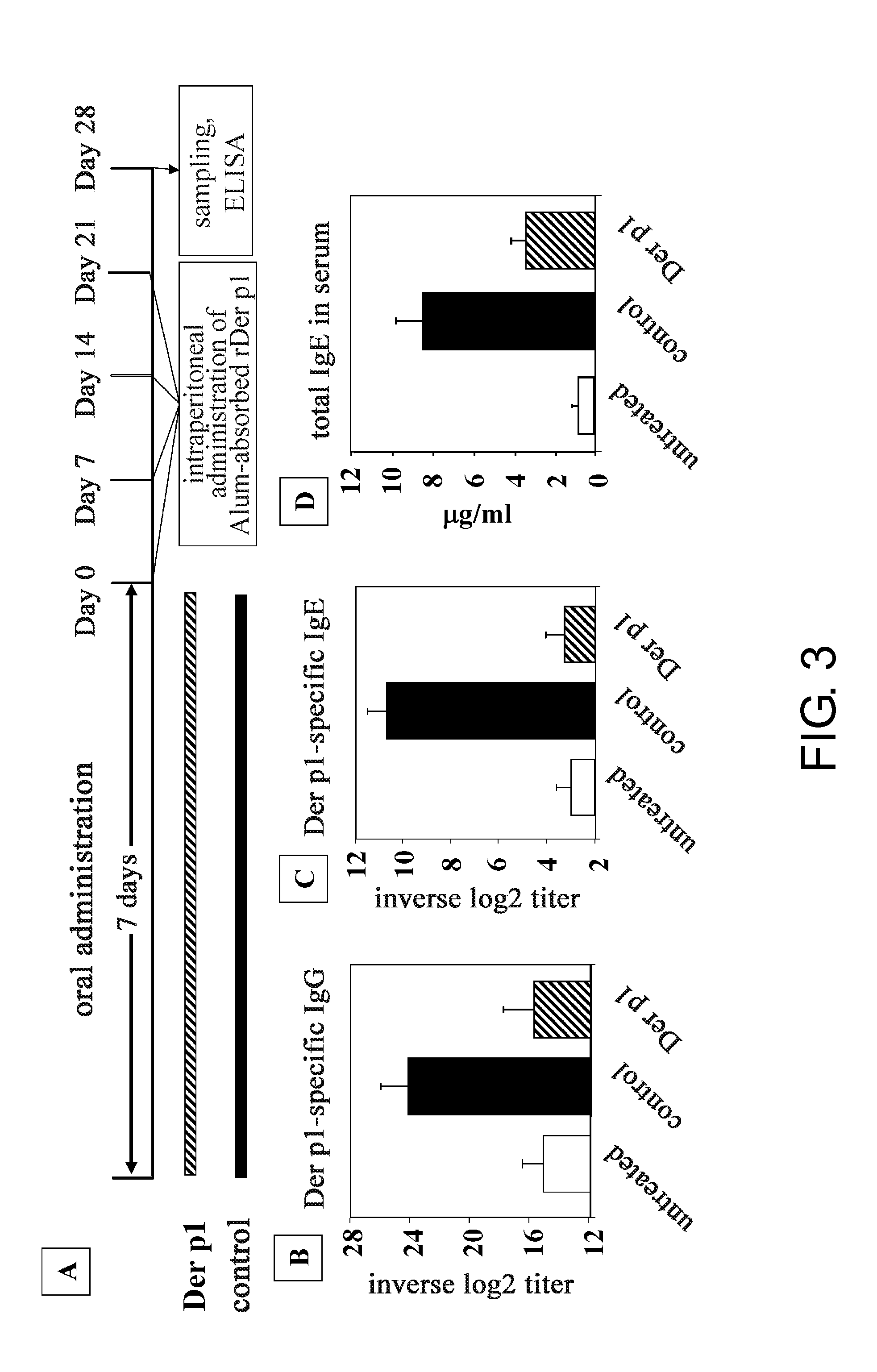Mite antigenic rice
a technology of antigenic rice and mite, which is applied in the field of mite antigenic rice, can solve the problems of anaphylactic shock, difficult to achieve, and difficult to achieve the effect of preventing the spread of mite,
- Summary
- Abstract
- Description
- Claims
- Application Information
AI Technical Summary
Benefits of technology
Problems solved by technology
Method used
Image
Examples
example 1
Expression and Accumulation of Der p1 Peptide in Rice Seeds
[0161]The gene (Der p1 45-145) encoding a part (amino acids: Ser45 to Asp145) of Der p1 protein was synthesized in accordance with the frequency of codons used in rice seeds. The nucleotide and amino acid sequences are shown in FIG. 1, and also in SEQ ID NOs: 9 and 10. An NcoI site and a SacI site were added to the 5′ and 3′ ends, respectively, for subsequent cloning. Furthermore, the sequence encoding KDEL (Lys-Asp-Glu-Leu), a signal for the endoplasmic reticulum was attached to the C terminus of the amino acid sequence, and a stop codon was added immediately after the signal. This gene fragment was inserted between the GluB-1 promoter and terminator, and subcloned into pGPTV, a plant transformation vector, to prepare a construct for plant transformation (FIG. 2A).
[0162]Rice seed-derived calluses were infected with the construct using the Agrobacterium EHA105 strain to create transformed rice plants. Proteins were extracted...
example 2
Effect of Der p1 Rice Orally Administered to Mice
[0164]Each of the control rice and Der p1 transformant rice (hereinafter also referred to as Der p1 rice) obtained in Example 1 was ground in a food processor, combined with commercially available powdered mouse feed at a ratio of 1:1, and orally administered to mice by free uptake for seven days. Then, for immunization, a suspension containing 5 μg of Der p1 protein and 0.4 mg of Alum was intraperitoneally administered to the subject mice four times at one week intervals. Sera were collected seven days after the final immunization, and the antibody titers of Der p1-specific IgG and IgE were determined by ELISA. The schedule of administration and subsequent immunization is shown in FIG. 3A. According to the result, Der p1-specific IgG and IgE were detected at high levels in mice orally administered with the control rice as compared to in the sera of naive mice, while Der p1-specific IgG and IgE were detected only at low levels in sera...
example 3
Subclass Analysis of Der p1-Specific IgG
[0165]The subclasses of IgGs in the sera collected from mice of each experimental group were analyzed. The measurement was carried out by the ELISA method, similarly as described above. IgG1 and IgG2b were efficiently induced by immunization with Der p1 in the sera of mice administered with the control rice, when compared to naive mice. In contrast, induction of antibodies of these IgG subclasses was not detected in the sera of mice administered with Der p1 rice (FIGS. 4A and 4C). There was no significant difference in the antibody titer between the IgG2a and IgG3 subclasses (FIGS. 4B and 4D).
PUM
| Property | Measurement | Unit |
|---|---|---|
| Composition | aaaaa | aaaaa |
| Conformation | aaaaa | aaaaa |
Abstract
Description
Claims
Application Information
 Login to View More
Login to View More - R&D
- Intellectual Property
- Life Sciences
- Materials
- Tech Scout
- Unparalleled Data Quality
- Higher Quality Content
- 60% Fewer Hallucinations
Browse by: Latest US Patents, China's latest patents, Technical Efficacy Thesaurus, Application Domain, Technology Topic, Popular Technical Reports.
© 2025 PatSnap. All rights reserved.Legal|Privacy policy|Modern Slavery Act Transparency Statement|Sitemap|About US| Contact US: help@patsnap.com



